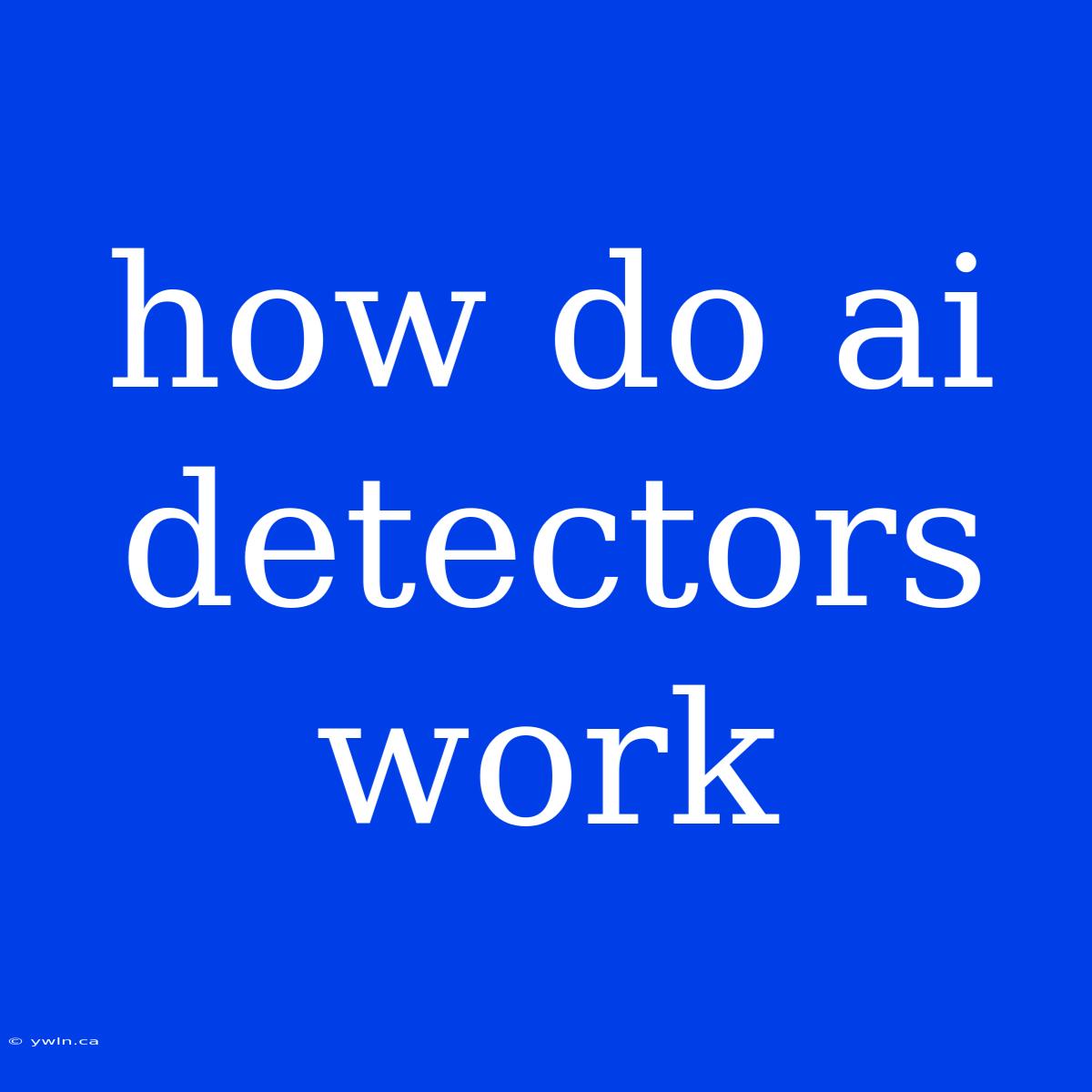Unmasking the AI: How Do AI Detectors Work?
Can you tell if a text was written by a human or an AI? The rise of powerful AI writing tools has sparked this question, leading to the development of AI detectors. But how do these tools work? Let's delve into the inner workings of AI detectors and understand how they distinguish between human and AI-generated content.
Editor Note: AI detectors are gaining increasing prominence as the lines between human and AI writing blur. Understanding their mechanics can be crucial for educators, researchers, and anyone concerned about the authenticity of online content.
Analysis: This guide explores the intricate workings of AI detectors, analyzing their techniques and limitations. We'll investigate various methods, including statistical analysis, pattern recognition, and language modeling, providing insights into how these tools decipher the nuances of human and AI-generated text.
Key Takeaways:
| Key Takeaway | Description |
|---|---|
| Detecting Statistical Inconsistencies | Analyzing patterns in word frequencies, sentence length, and other statistical markers. |
| Identifying Stylistic Differences | Identifying unique writing styles and patterns characteristic of AI models. |
| Leveraging Language Models | Comparing generated text against known AI models to identify similarities. |
| Analyzing Semantic Relationships | Analyzing the relationships between words and phrases to identify potential AI markers. |
Understanding the Techniques
AI detectors employ various techniques to differentiate between human and AI-generated content:
Statistical Analysis
- Introduction: This technique analyzes statistical patterns in text to identify anomalies.
- Facets:
- Word Frequency: AI models often exhibit predictable word usage, deviating from human writing habits.
- Sentence Length: AI-generated text may have more uniform sentence lengths than human-written content.
- Grammar and Punctuation: Subtle variations in grammar and punctuation can be indicators.
- Summary: By analyzing statistical characteristics, AI detectors can flag texts with unusual patterns suggestive of AI authorship.
Pattern Recognition
- Introduction: This method focuses on identifying specific patterns in language that are common to AI models.
- Facets:
- Repetitive Phrases: AI models may use repetitive phrases or sentence structures.
- Overuse of Certain Words: AI models can be biased towards specific words or phrases.
- Lack of Nuance: AI writing may lack the richness and depth found in human writing.
- Summary: Pattern recognition helps AI detectors identify text that exhibits characteristics commonly associated with AI models.
Language Modeling
- Introduction: This technique uses pre-trained language models to compare generated text against known AI models.
- Facets:
- Model Similarity: Detecting if the generated text aligns with the output of specific AI models.
- Predictive Accuracy: Assessing how well a language model can predict the next word in a sequence.
- Model Confidence: Analyzing the confidence level of the AI model in generating the text.
- Summary: Language modeling provides a powerful tool for identifying text generated by specific AI writing models.
Limitations of AI Detectors
While AI detectors offer valuable insights, they have limitations:
- Constant Evolution: AI models are constantly evolving, making it challenging to keep detectors up-to-date.
- Contextual Understanding: Detecting AI-generated text can be difficult when the content is complex or highly specialized.
- False Positives: AI detectors can misinterpret human writing as AI-generated, leading to inaccurate results.
FAQs about AI Detectors
Q: Can AI detectors always tell if text is AI-generated? A: No, AI detectors are not foolproof and may produce false positives or negatives. They are tools that provide probabilistic evidence rather than definitive answers.
Q: What are AI detectors used for? A: AI detectors have applications in education, research, content creation, and online security to identify potential plagiarism, ensure authenticity, and maintain content integrity.
Q: Is it ethical to use AI detectors? A: The ethical implications of AI detectors are a subject of ongoing debate. While they can help identify potential misconduct, they can also be used to restrict creativity or unjustly penalize individuals.
Q: What's the future of AI detectors? A: AI detectors are likely to become more sophisticated, adapting to the evolving landscape of AI writing tools. However, the arms race between AI writing and detection technologies is likely to continue.
Tips for Avoiding Detection
While AI detectors are becoming more advanced, certain strategies can help minimize the likelihood of detection:
- Human Editing: Review and edit AI-generated text to add human-like nuances and avoid repetitive patterns.
- Contextual Awareness: Ensure the generated text aligns with the specific context and purpose.
- Diversity of Sources: Combine AI-generated content with human-written material to create a more natural and diverse text.
- Utilize Unique Styles: Experiment with different writing styles and formats to avoid predictable patterns.
Summary by AI Detectors
AI detectors are tools that help us understand the growing intersection of human and AI writing. While they offer valuable insights, their limitations must be acknowledged. Ultimately, the ethical use of AI detectors and the ongoing development of responsible AI writing practices are crucial for a future where AI and human creativity coexist harmoniously.
Closing Message:
The future of AI detectors remains uncertain, but their presence highlights the need for responsible AI development and ethical use. As AI writing technology continues to advance, it is essential for individuals and institutions to engage in informed discussions about its implications and find ways to harness its potential while mitigating potential risks.

